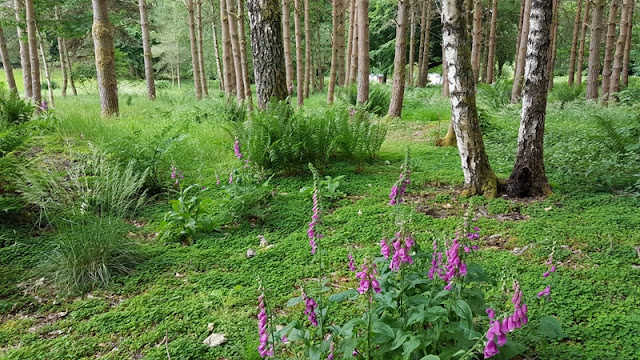Our woodland used to be part of a larger estate. Some old
documents refer to it as the woodland garden, but later maps call it Sawmill
Wood. It seems that it was originally set out as a formal woodland, visible
from the big house. I have seen photographs from the middle of the 1900s and it
all appears to be large deciduous trees, with one picture showing some haystacks,
so obviously there was grass growing under them.
In the 1970s it seems that a lot of the larger trees were
cut down and there were quite a few areas around the estate that were planted
with Norway Spruce and Scots Pine as a Christmas tree crop. Sadly the owners of
the estate died shortly afterwards and the land was split into several smaller
lots and sold off.
We had three compartments of “Christmas trees” on our land,
two of Pine and one Spruce, each about two acres. The trees were now about 50
years old and about 80 feet tall. It was interesting to see that the ground
under the Spruce was completely bare, with no grass, wild flowers or young
trees growing. Under the Pine there was at least some vegetation, but it was
quite sparse.
Two years ago we decided to have the Spruce plantation
clear-felled and the adjacent Pine plantation thinned. This turned out to be
quite a messy operation, as typically it coincided with a period of sustained
rain! The forestry vehicles sank into the ground, so they used the brash from
the trees to make temporary tracks. The mud trailed down our drive to where the
trees were stacked, ready for collection. Once the work was completed we were
left with a scene of devastation, with enormous piles of brash and branches
scattered all over the area.

I spent the following year trying to clear the ground
sufficiently to allow me to re-plant the area. This presented me with quite a
dilemma. The whole idea of taking the Spruce down was to replant the area with
native broadleaf trees that would provide a much better habitat for wildlife.
Now I found myself having enormous bonfires. It felt so wrong to be producing
all of this carbon dioxide, particularly after I had arranged to have the CO2-absorbing
trees felled.

A little bit of research was required. I know that you can’t
believe all that you read on the internet, but I discovered a study that had
been undertaken in Scandinavia. The researchers measured the CO2
levels in a conifer forest prior to and after felling. It seems that for the
first 15 years after felling and replanting a woodland the microbes in the soil
produce more CO2 than the young trees absorb. For the next 15 years
the trees absorb more CO2 than the microbes produce, but it takes
that time to balance out the previous 15 years. So, it is only after 30 years
that the woodland becomes a net CO2 sink.
I also read that if you leave wood to rot, rather than
burning it, the greenhouse gases produce are about the same, but obviously they
are released over a much longer period. All interesting stuff, and quite
alarming!
I also decided that it was better to leave piles of branches to break down, which would at least provide shelter for all sorts of wildlife rather
than burn everything. Clearly the wood would be eaten by various invertebrates
and then the rest of the food chain. Surely this would be a form of carbon
sequestration.
It was very interesting to see how quickly the ground became
colonised by wild flowers (or weeds, depending on how you look at it!). That
first summer there was a carpet of Woodland Groundsel, Senecio sylvaticus, and a number of Spear Thistles, Cirsium vulgare, providing loads of
flowers. There were also loads of young Foxglove plants, Digitalis purpurea, so the whole area had greened up by the end of
the summer. The picture below is the thinned Pine plantation.
The following winter I planted 700 native broadleaf trees. A
third of these were Sessile Oak (a condition of the felling licence) and the
remainder were made up of Birch, Rowan, Field Maple, Aspen, Hawthorn,
Blackthorn, Hazel, Crabapple, Cherry Plumb, Hornbeam and Willow. I also put in
some Walnut trees, which are not native, but I wanted an alternative large tree
and thought these could do well if the weather becomes warmer.
Many of these trees will provide flowers and fruit for pollinators,
birds and small mammals. The trees are planted at 3 metres apart, but I have
left open areas where I will continue to encourage wild flowers. I will also
make sure that the trees do not become so dense that they block the light to
the greenery growing below them.
It was lovely seeing the number of bumblebees enjoying the
Foxgloves this summer and it is very exciting seeing the trees starting to
grow. Some of them have even reached the top of their protective tubes. Despite
the hard frosts last winter I only lost six trees out of the 700 planted. This is a picture I took this winter.
I am really looking forward to watching this area develop over
the next few years.


























